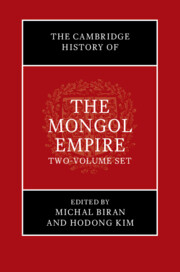Book contents
- The Cambridge History of the Mongol Empire
- The Cambridge History of the Mongol Empire
- Copyright page
- Dedication
- Contents
- Figures in Volume I
- Figures in Volume II
- Maps in Volume I
- Maps in Volume II
- Tables in Volume I
- Contributors to Volume I
- Contributors to Volume II
- Acknowledgments
- Notes on Dates and Transliterations
- Abbreviations
- Volume I
- Introduction
- Volume I Part 1 Political History
- Volume I Part 2 Thematic Histories
- 6 Mongol Imperial Institutions
- 7 Imperial Ideology
- 8 The Military Machine
- 9 Economic Exchange
- 10 Religious Exchange
- 11 Scientific Exchange
- 12 Artistic Exchange
- 13 The Climate and Environment of the Mongol Conquest
- 14 Women and Gender under Mongol Rule
- Volume I Part 3 Views from the Edges
- Volume I Part 4 External Histories
- Epilogue
- Volume II
- Index to Volume I
- Index to Volume II
- References
12 - Artistic Exchange
from Volume I Part 2 - Thematic Histories
Published online by Cambridge University Press: 01 January 2024
- The Cambridge History of the Mongol Empire
- The Cambridge History of the Mongol Empire
- Copyright page
- Dedication
- Contents
- Figures in Volume I
- Figures in Volume II
- Maps in Volume I
- Maps in Volume II
- Tables in Volume I
- Contributors to Volume I
- Contributors to Volume II
- Acknowledgments
- Notes on Dates and Transliterations
- Abbreviations
- Volume I
- Introduction
- Volume I Part 1 Political History
- Volume I Part 2 Thematic Histories
- 6 Mongol Imperial Institutions
- 7 Imperial Ideology
- 8 The Military Machine
- 9 Economic Exchange
- 10 Religious Exchange
- 11 Scientific Exchange
- 12 Artistic Exchange
- 13 The Climate and Environment of the Mongol Conquest
- 14 Women and Gender under Mongol Rule
- Volume I Part 3 Views from the Edges
- Volume I Part 4 External Histories
- Epilogue
- Volume II
- Index to Volume I
- Index to Volume II
- References
Summary
Although Mongol authority built its empire through military might and administration, the cultural construction of empire happened through artistic exchange. Visions of desire, beauty, and power – as well as the materials that made creativity possible – were essential to the ideological projects of Mongol imperial reach. As governors of a Eurasian-wide commercial empire, Mongol rulers required effective visual representations of their power that could easily be understood by diverse audiences. This could be achieved through widespread dissemination and integration of material culture. Reliance on already recognizable symbols of authority that could be adapted and repurposed for contemporary political goals was both expedient and effective.
Keywords
- Type
- Chapter
- Information
- The Cambridge History of the Mongol Empire , pp. 575 - 602Publisher: Cambridge University PressPrint publication year: 2023

